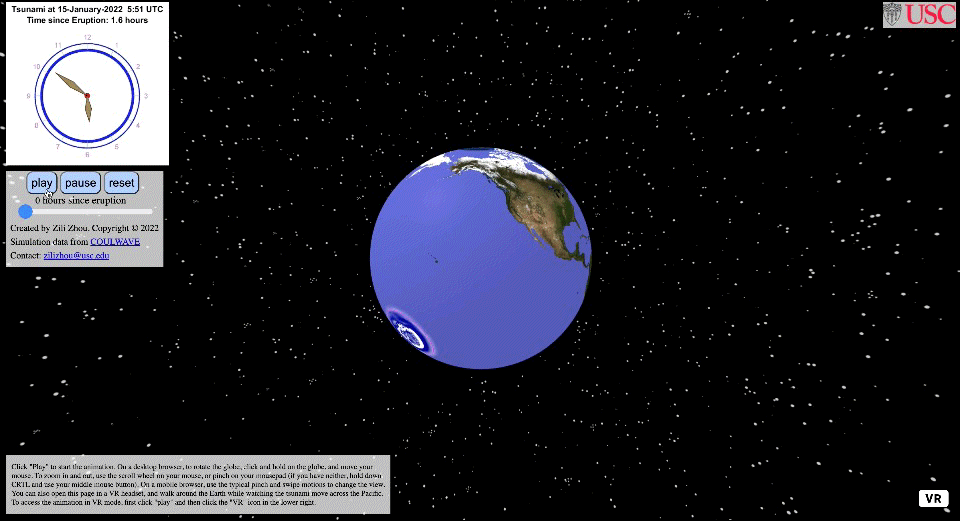
Interactive model of the global tsunami generated by the January 2022 Hunga Tonga-Hunga Ha’apai volcano eruption
In 1883, there was a volcanic eruption so large, it killed tens of thousands of people. It expelled so much ash into the sky that, for a period of time, it changed the colors of the sunsets the world would see and the palette with which Impressionist painters would paint. In history, few volcanic eruptions had been so documented, until a recent underwater eruption earlier this year occurred off on the island nation of Tonga.
The impact of the January 2022 Hunga Tonga-Hunga Ha’apai volcano was recorded by USC Viterbi Professors Patrick Lynett, Costas Synolakis and their students, and by their colleagues at eCoast Marine Consulting and Research in New Zealand, the Tonga Meteorological Service, the New Zealand National Institute of Water and the US Geological Survey. Their research represents the first time a team of researchers was able to simultaneously collect oceanic, atmospheric, space data from a large underwater volcanic explosion. Their findings were shared in an article published in Nature.
The underwater explosion of the volcano flash boiled the ocean, creating a 300-ft deep and 5-mile wide crater in the ocean surface. You read that right: Five miles wide. The tsunami from this explosion sped away from the volcano towards the islands of Tonga moving at 250 miles per hour. Lynett, of the Tsunami Research Center at USC, puts this explosion in perspective: People on the islands of Tonga from 50 miles away, could feel their ears pop from the pressure change generated by the explosion. This tsunami reached Tonga in 10 minutes and flooded land up to an elevation of 60 feet, devastating resort communities.
The impact of this explosion and the tsunami it generated was not limited to Tonga and the Southern Pacific Ocean. Lynett says the eruption generated a global tsunami, reaching California and even the Mediterranean Sea. Such a global tsunami was not generated directly by the explosion, but by a pressure pulse from the eruption that traveled in the atmosphere – the same pressure pulse that caused locals’ ears to pop. This pressure pulse was remarkably stable, was recorded on weather stations throughout the world, and traversed the globe multiple times. When it traveled over oceans, the pulse pushed the ocean surface with it, continually creating tsunamis throughout the world. In California, as well as Hawaii and South America, the tsunami was similar in size to that from the great Japan earthquake of 2011. (A screengrab of the interactive model of this tsunami is below but the full, interactive experience can be found here . )
It is obvious that tsunamis can cause considerable damage to coastal areas. But the rising sea levels created by climate change can compound the situation, says Lynett who has continuously worked with planners and policymakers to understand the dangers. This is particularly important in marinas and harbors. When the tsunami height is greater than the height of the pilings, docks and the vessels connected to them float off the pilings and act as projectiles in the harbor. This situation, caused by the Tonga eruption, was narrowly avoided in some harbors in California. As the authors of the paper say, “Catastrophic damage in some harbors … was averted by just tens of centimeters, implying that a modest sea level rise combined with a future, similar event would lead to a step-function increase in impacts on infrastructure.”
Lynett has also indicated that since it is the first time an explosion of this size has been documented, it does not mean that it hasn’t happened more frequently in the past. Indeed, there are underwater volcanoes all over the world, many of them in the Pacific, as well as in the Caribbean. Currently, emergency planning, mitigation efforts, and infrastructure design do not consider volcanic source tsunamis. However, as the authors state: “Understanding the Hunga Tonga event has broad implications … for maritime and near-shoreline infrastructure under threat of sea-level rise, where the global tsunamis from large volcanic eruptions are currently neglected.”
Read the full paper in Nature.
Published on August 31st, 2022
Last updated on August 31st, 2022












